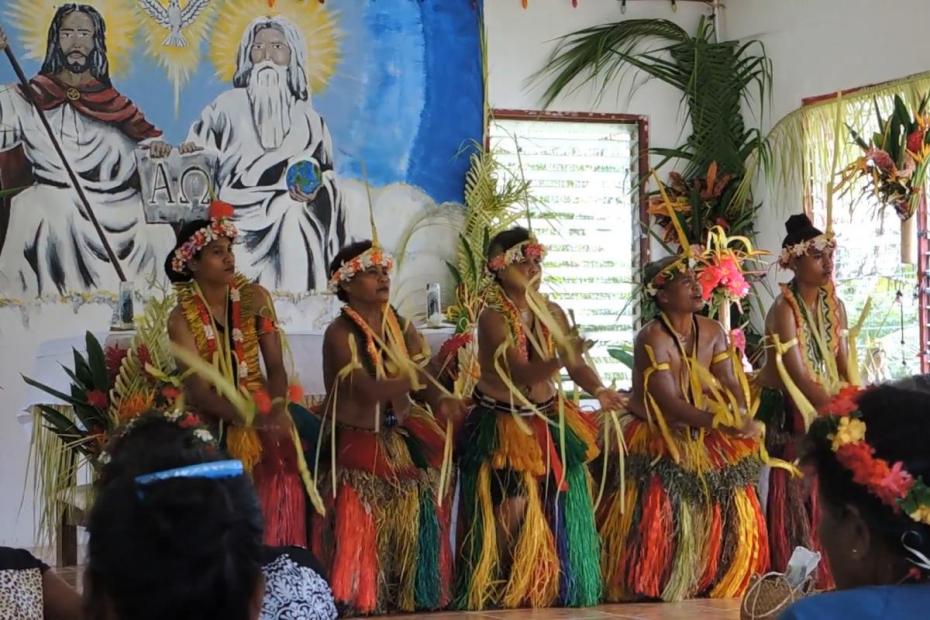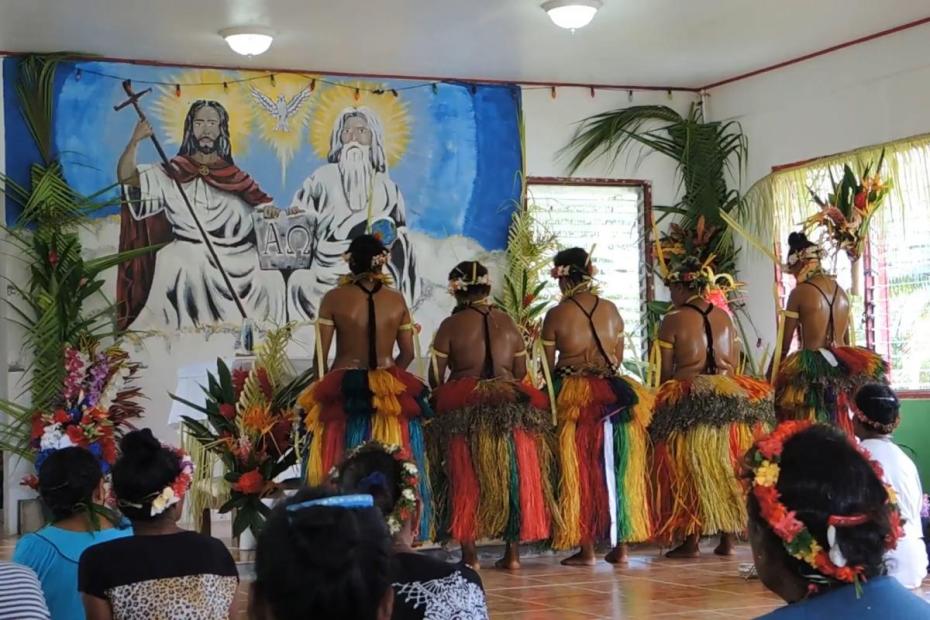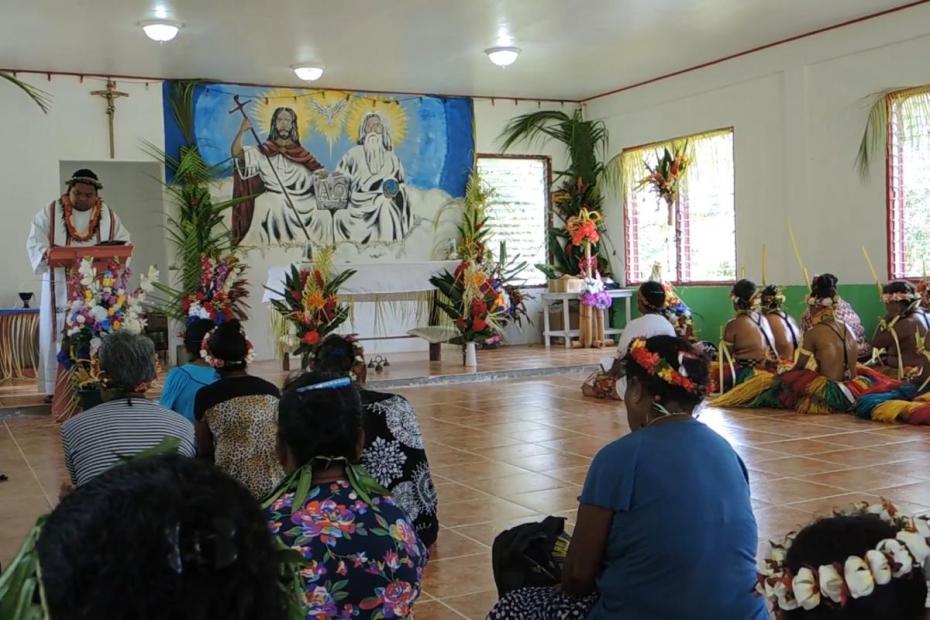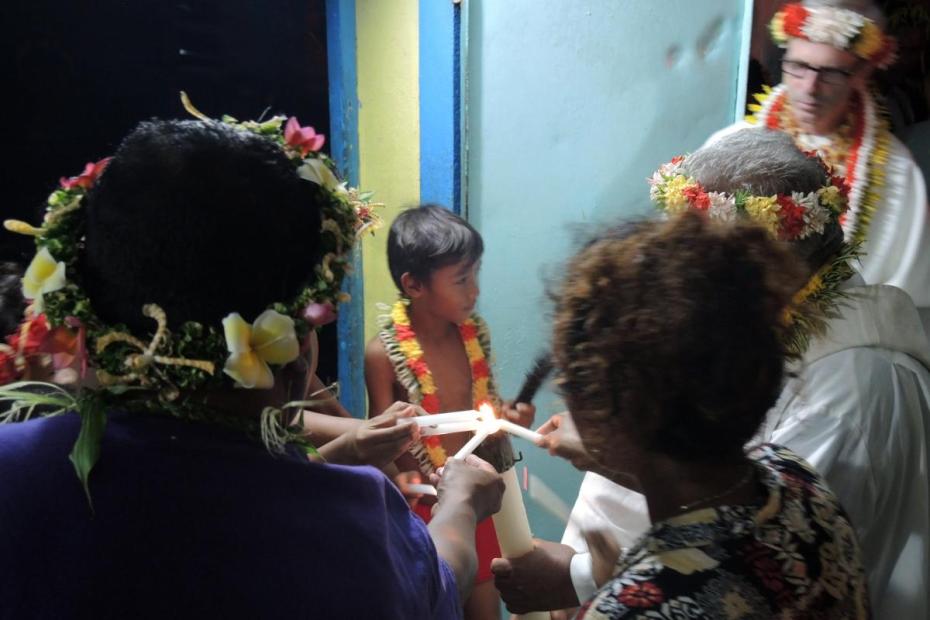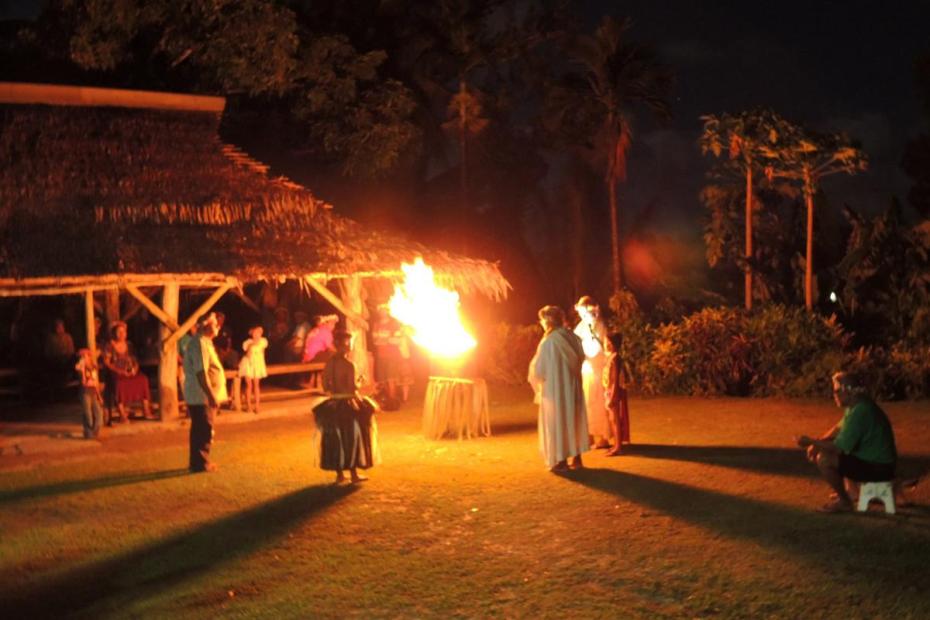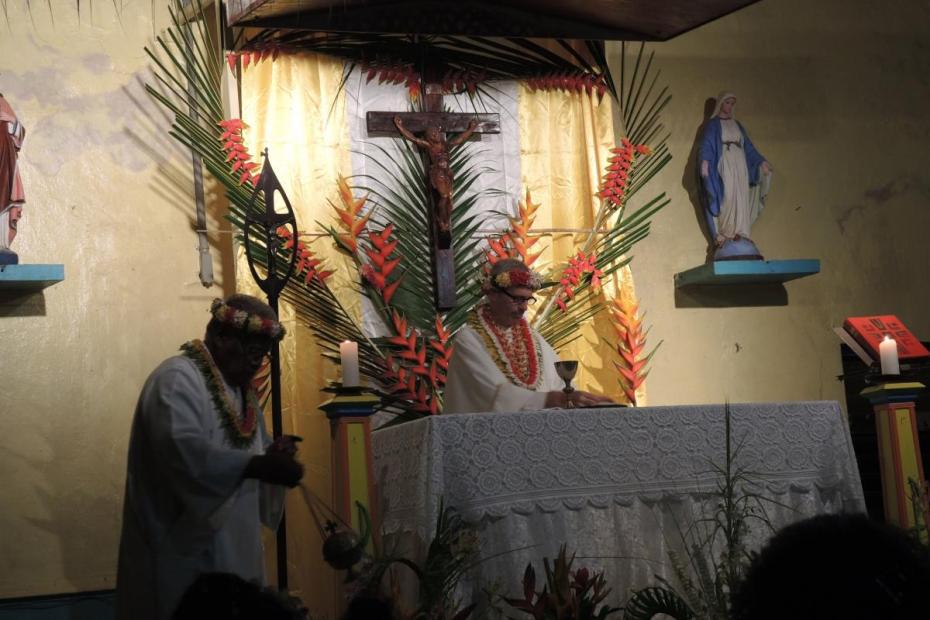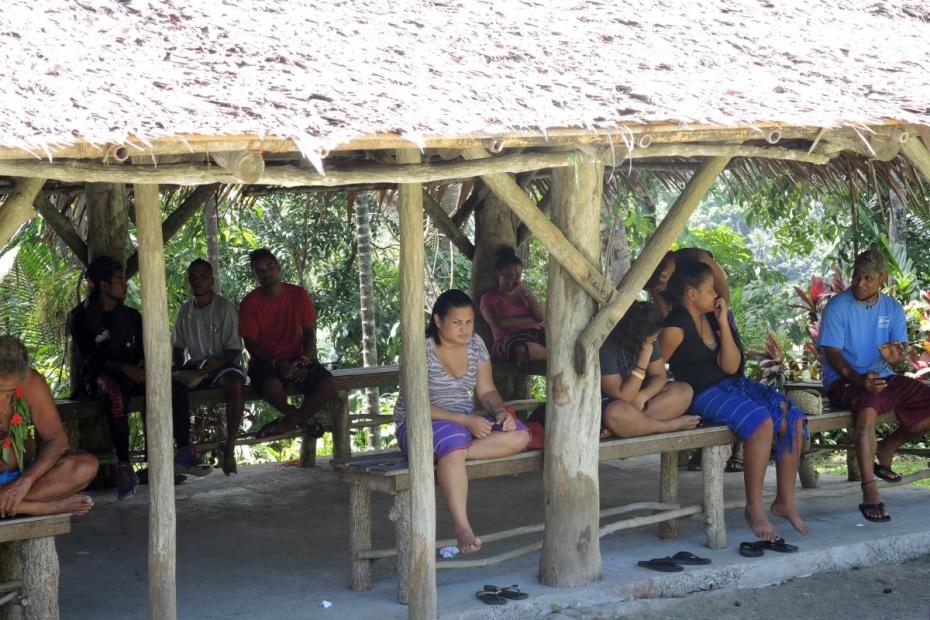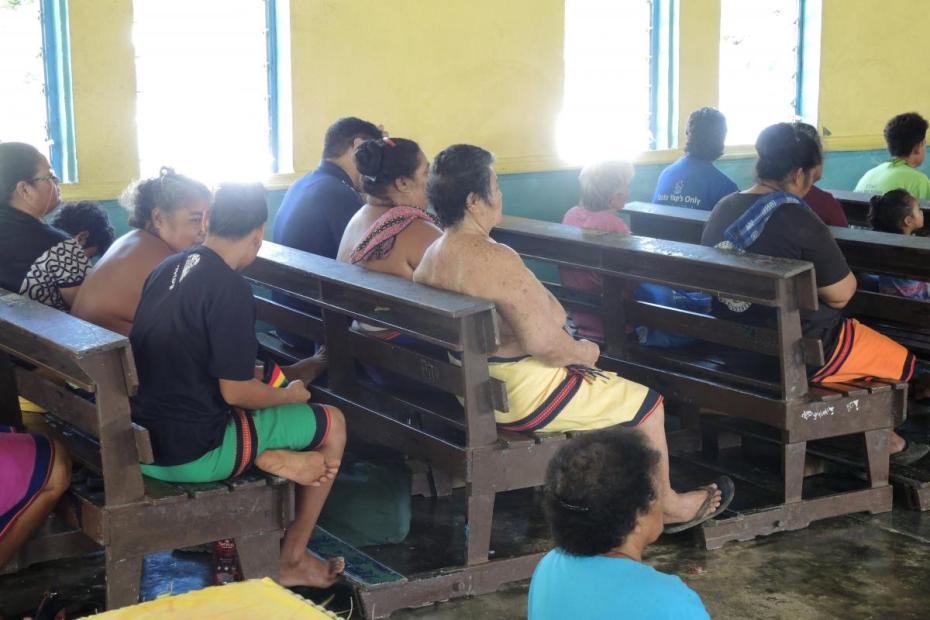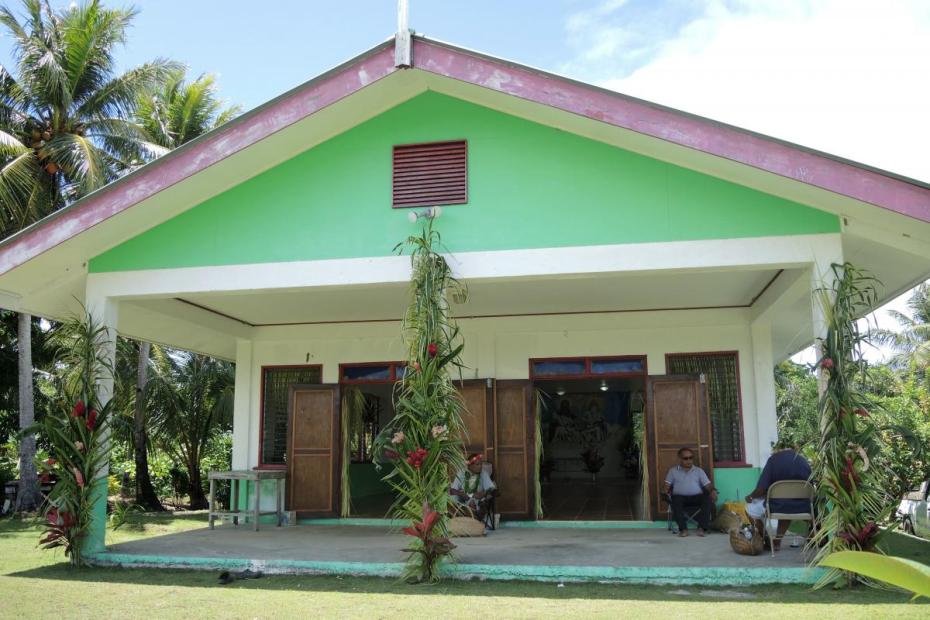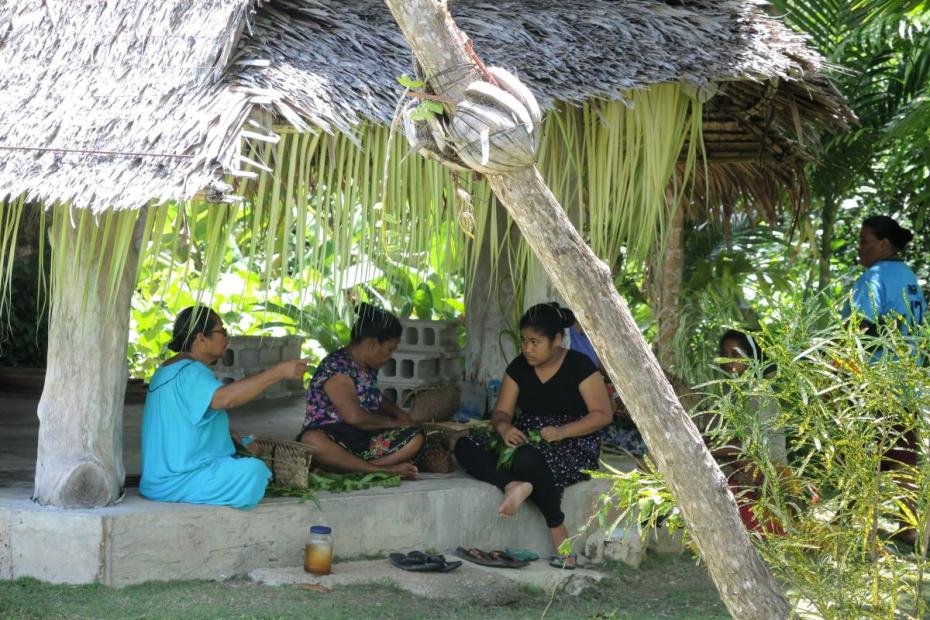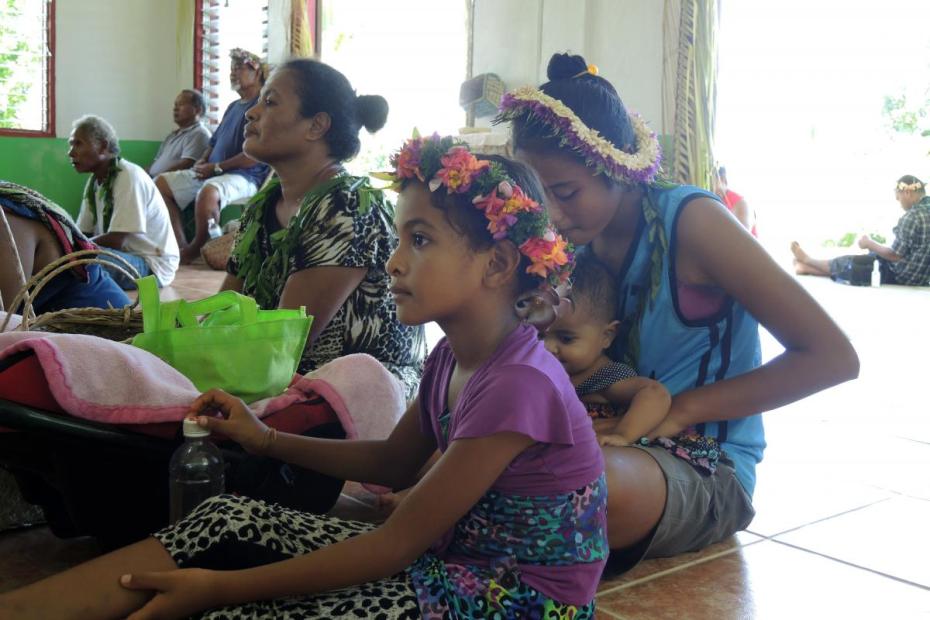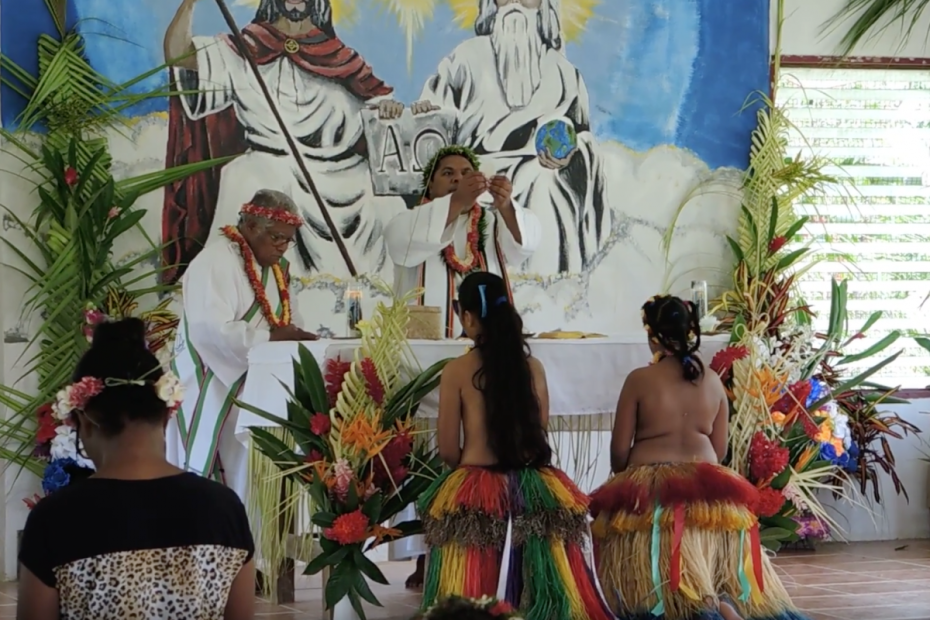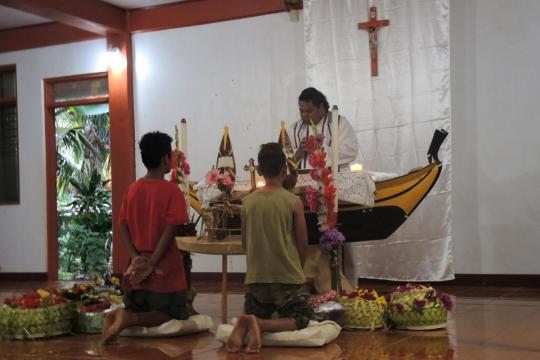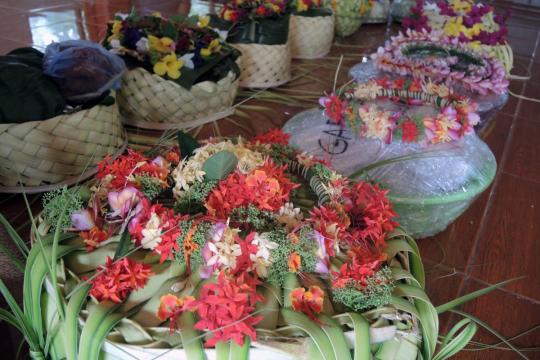Dance is often described as one of the most important, if not the most important, mode of cultural expression in Yap. At both Christmas and Easter liturgies, dance is even incorporated into Catholic worship, to communicate the importance of these days and to help tell the stories behind them. Yapese Catholics spoke about these dances as means to communicate what’s most sacred and deep about the Christian story in their own language and mode of expression.1
The Easter dance has no special name that anyone I interviewed knew of, but it is described as a dance of thanksgiving. It seems to have been devised for the Easter vigil, but because of the large number of village churches and the modest number of priests, is danced in the Easter vigil at the main church, and at some Easter Sunday Masses elsewhere. As shown in video posted here, it fits in the context of an otherwise typical liturgical form for those celebrations.
The Easter dance was introduced in 1986 or 1987 by the first Yapese Catholic priest, a much-revered but now deceased Jesuit, Fr. Apollinaris (Apollo) Thall. Thall composed its lyrics and Elvira Tinag, a local woman highly respected for her knowledge of the dance, choreographed it.2
The text of the dance, which includes singing, uses archaic, “high” forms of spoken Yapese, which highly educated Yapese/English speakers found hard to translate literally. They translated it as follows:
Listen up! It says:
The Lord is resurrected
The Light that lights up the world, being revealed.
The Light of life and the Light of eternal bliss that illuminates the world.
The Lord is raised from the dead to be revealed to everyone. (repeat, repeat)
The Lord is raised from the dead to be revealed to everyone. (repeat, repeat)
The Light of life and the light of spirit.
(Dancers and congregation) Reveal it to everyone!
Light of life and light of spiritual bliss
(Dancers and congregation) Reveal it to everyone!
We offer thanks to God and thanks to Christ.
He rid the world of darkness.
He brought a light that is so bright. Christ has brought us back to life abundant, without end.
We offer thanks to God and thanks to Christ who got rid of the darkness over the world, bringing prosperous life forever.
Alleluia, Alleluia.
We offer thanks to God and thanks to Christ who got rid of the darkness over the world, bringing prosperous life forever.
Alleluia, Alleluia.
We offer thanks to God and thanks to Christ who got rid of the darkness over the world, bringing light that illuminates the world, and prosperous life forever.
-Text by Rev. Apollonis Thall, S.J., translated by Rev. Cuthbert Yiftheg and Elizabeth Ribilayan, April 2018
The form of the dance derives from the tayor (or tayoer) dance, a line dance by women. One woman explained, “Because it’s a church event, it’s a chiefly dance, not a lowly one… an exalted dance, the highest type of dance in Yap, fit for the seriousness of the occasion.” She explained that the word tayor means “the cry,” or the act of crying out a message. The dance form, she said, signals that the dance carries a message and demands something from the audience, beginning with their attention. A male interviewee said that the shouts from men in the audience that sometimes punctuate the dance signal the status of the dance as an epic tale.
Tayor dancers are supposed to be granted what they are asking for. In its traditional form, the something it could demand from the audience could be a pig or other foodstuff, she said. As anthropologist C. Jason Throop explains it, a tayor dance in its traditional context details the relationship between two villages, articulating what each had done for the other, and calling for a reckoning for the wrongdoing of one village in relation to another.3 Ultimately, the demand of food is in compensation for that. In this light, the Easter dance makes sense as a recounting of what Jesus and the Father have done for the people, and what the people owe him in return.
The tayor dance, whether performed in inter-village settings or in church, is only performed by women, standing, always in line facing the audience. Padre Thall wanted the elder women to dance it. “He demanded that the elders proclaim the Easter message.” One even remembered dancers who needed a cane. Younger women perform it with older women today, something that did not entirely make some of the elder women happy, because they feared that only senior women could adequately convey its seriousness. Young people, they worried, don’t often understand its archaic language, which has to be properly conveyed.
Initially, the dance at the Easter vigil was performed outside, at the bonfire and the lighting of the Easter candle. At some point it had been moved inside, but beginning in 2019 will be moved back outside.4
Dance as a school of virtue
Westerners, among others, likely have to abandon almost all of their assumptions about what dance is about if they want to understand what it means to Yapese. In Yap, dance is not about breaking free from social norms. It is not about self-expression, romance or sexual expression. Nor is it a form of entertainment. Quite the contrary, it is a school for learning, expressing and reinforcing traditional values.5 Dance occurs on important days, and articulates the values and relations of the community. In a culture where men and women in romantic relationships do not express their affection in public, traditionally there are few frivolous or romantic occasions for dancing.6
A successful dancer in Yap—at a village or inter-village event, on Yap Day, or at Christmas or Easter Mass—practices careful, almost complete restraint, surrendering to and embodying the requirements of the dance. Both preparation and performance are meant to be an ascetic experience. The dancer shows no emotion and is not supposed to stand out. The lack of emotion in the dance flows from, but also communicates, the value of what one interviewee referred to as the “stoic ideal” in Yapese culture. “You are taught not to be expressive, to keep to your own mind, not to show [what you are thinking,]” she said. The cultural ideal in Yap says that one’s inner life should be subordinated to the needs of the family, lineage and village.7 In Yap, these are also perceived by extension as Christian virtues.
Dance, says one anthropologist who has studied it extensively, is meant to communicate “ideals of self-monitoring, self-reflexivity, self-restraint, and self governance, as well as… mastery of the body.” It is intended to form “a distinctly Yapese moral modality of being... helping individuals craft particular forms of feeling, thinking, appreciating, judging, imagining and behaving that are consonant with local understandings of the good person, the good life, and right action.”8 It teaches what the culture values: self-abnegation and self restraint.
The women dancers wear grass skirts, garlands made from flowers and leaves, and rub their bodies in coconut oil and turmeric. For women to be topless, as they dance and in one sub-parish serve at the altar for the Christmas and Easter dances, is not an expression of sexuality or a source of anxiety for the predominantly Catholic population of Yap. Toplessness is the norm for women and men at special occasions like Yap Day, or at public and Catholic school graduations. In daily life, it was the norm until the 1970s, and although it is less common now for younger women, it is not unusual on the streets and among congregants at Mass.9 For a woman to show her thighs, though, as Western women would in shorts or a bathing suit, is considered extremely provocative. Women are aware of Western norms, and on the main islands usually wear blouses. But when it comes time to do otherwise, because it is expected, young women said that it feels normal.
At one time, interviewees reported, all the parishes and sub-parishes in Yap created their own dances. Some parishioners were resistant to them, having been taught that dance was incompatible with church. Some discontinued the dances over time, but interviewees reported that one sub-parish, on Maap, one of the four main island-villages of Yap, uses dance for catechetical instruction outside of the liturgy. The themes of these dances, they reported, include Adam and Eve, the Mother of God, Fatima, and John the Baptist. As Throop discovered in his exploration of secular dance forms in their original context on Yap, Yapese believe that the embodiment of the dance is the perfect way to teach the lesson. As one Yapese told him, “By striving to learn the dance inside the body, it will not ever be forgotten.”10
Read more
C. Jason Throop, “‘Becoming Beautiful in the Dance’: On the Formation of Ethical Modalities of Being in Yap, Federated States of Micronesia” Oceania, 79, 2009, 179-201.
- 1The entry on the Easter dance is based on participation in the congregation and on interviews with 11 Yapese and Outer Island Catholics, on and less formal discussions with a dozen others during Holy Week and part of Easter week, 2018. Several anonymous interviewees with particular knowledge of the history of the dance were especially helpful. Particular thanks to Elizabeth Ribalayan and Rev. Cuthbert Yiftig who devised the translation, and to the parish for allowing the dance to be video recorded and shared outside for the first time.
- 2The account of the origin of the dance relies on remembrances during interviews with a number of elders, including one who had danced it.
- 3C. Jason Throop, “‘Becoming Beautiful in the Dance’: On the Formation of Ethical Modalities of Being in Yap, Federated States of Micronesia” Oceania, 79, 2009, 185.
- 4The shift is not a question of status. The non-Yapese speaking Outer Island and American priests in the parish who came in Fr. Thall’s place had been told that the words of the dance recounted the Easter story, so they placed it in the point of the liturgy inside the church closer to when that story is being read. Given the translation above, the priests realized what it did mean, and indicated that they plan to move it back outside, to associate it with the bonfire and the light of the Easter candle.
- 5Throop, “‘Becoming Beautiful in the Dance,’”184.
- 6Here is a place where one has to wonder how the internet and its promotion of Western youth culture will affect this. Young people are clearly aware of Western (and Asian) youth culture, through radio and TV. High-speed internet, arriving in summer 2018, may exacerbate the trend.
- 7Throop, “‘Becoming Beautiful in the Dance,’” 182-184, 194.
- 8Throop, “‘Becoming Beautiful in the Dance,’” 180.
- 9Francis X. Hezel, S.J., Making Sense of Micronesia: the Logic of Pacific Island Culture (Honolulu: University of Hawai’i, 2013), 9.
- 10Throop, “‘Becoming Beautiful in the Dance,’” 191.
